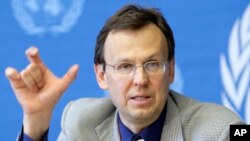In advance of World TB day (March 24), the World Health Organization is calling for collective global action and more money to support TB control strategies to end this scourge by 2030.
The World Health Organization says ending tuberculosis by 2030, the target set by the U.N. Sustainable Development Goals will be a challenge, but it can be done. It notes 43 million peoples’ lives have been saved since 2000.
WHO says countries can save the lives of the 1.5 million people who continue to die from tuberculosis every year by strengthening TB programs and adopting newer tools.
Director of WHO’s Global TB Program, Mario Raviglione, says several of the 30 countries with the highest TB burden are implementing newer TB strategies with some success. One such country is India, home to more people ill with TB and multidrug-resistant TB than any other country in the world.
He says the country is making progress in providing universal access to TB care for patients.
South Africa is another country that has expanded access to a rapid molecular test for TB and drug-resistant TB.
“South Africa is, let us remember, home to the largest number of people living with HIV who are receiving also TB preventive treatment. So, worldwide there are these sort of pathfinders for prophylaxis of tuberculosis, which is one of the other new elements of the new strategy that we are very much insisting on because it prevents tuberculosis and saves lives," said Raviglione.
WHO cites Thailand, Russia, Brazil, and Vietnam for running successful TB control programs. The multinational health group UNITAID is working with the WHO by investing in effective approaches to end TB. For example, it is scaling up better TB treatment for children.
Every year, an estimated one million children become ill with TB and some 140,000 die. UNITAID team leader Janet Ginnard says medicines suitable for children in the right doses and formulations now are available.
She tells VOA before WHO revised its treatment guidelines, children were thought of as just little adults. She says no one recognized the need to tailor the dosage for children.
“So, the drugs that we had were either child-friendly dissolvable, but not in the right doses or crushed and split pills from adult medicines to try to make up those doses - so, both sub-optimal work-around solutions," said Ginnard.
Ginnard says these new child friendly medicines now can be bought on the market in doses that are right for treating tuberculosis in children.





